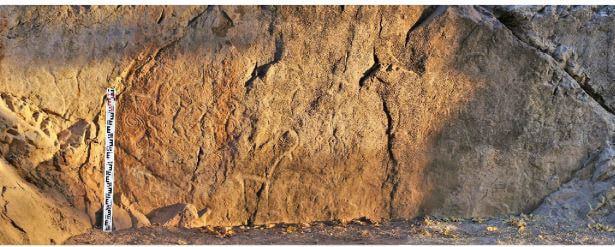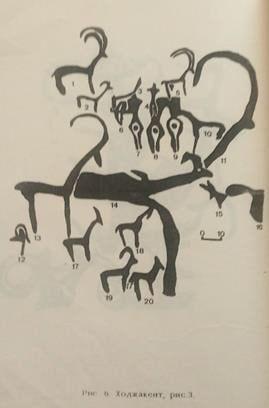History sealed in stone
🔴 A source speaking of our people’s history and beliefs
🔴 Spiritual heritage and the relevance of its preservation

The ancient Chach petroglyphs are expected to be featured in the pre-Islamic civilizations section of the Center of Islamic Civilization in Uzbekistan and are being displayed as living witnesses of our people’s spiritual heritage. These rock carvings are considered part of the world’s cultural heritage as humanity’s earliest forms of spiritual creativity. The Chach petroglyphs are found on the cliffs of the western Tianshan (Tangritagh). They depict the lifestyle of ancient people, their hunting and herding practices, religious beliefs, customs, and social relations. Therefore, they serve as a valuable source known as “history engraved in stone”. The images discovered in the Chach cliffs, particularly in the Tashkent oasis, hold not only local but also global significance for the development of world civilization. These carvings form part of humanity’s artistic heritage alongside the Lascaux caves in France, Altamira in Spain, and Gobustan in Azerbaijan.
Early research and study of the monuments
The first information about the images on the Chach cliffs was recorded at the end of the 19th century. In 1879, the Russian scholar D. M. Gramenitsky wrote about the drawings at Khojakent cliffs, later supplemented by S. A. Lidsky. From the 1940s and 1950s onward, systematic expeditions uncovered numerous sites. Scholars such as G. V. Parfyonov, Kh. A. Alpisboev, and M. M. Khodjanazarov contributed significantly. In particular, M. Khodjanazarov prepared a special monograph in the 1990s and developed a scientific classification of the Chach petroglyphs. These studies show that the drawings span from the 4th–3rd millennia BCE to the medieval period.
 At Khojakent, about 70 km northeast of Tashkent, more than 90 drawings have been documented. Most are hunting scenes and depictions of animals, especially mountain goats. Human figures are also found, shown with outstretched arms, holding bows, or in ritual poses. The discovery of three female figures on these cliffs is considered extremely rare in Central Asian rock art. Researchers date these images to the Neolithic–Eneolithic period. The Khojakent drawings reflect not only daily life but also the spiritual beliefs and customs of ancient society.
At Khojakent, about 70 km northeast of Tashkent, more than 90 drawings have been documented. Most are hunting scenes and depictions of animals, especially mountain goats. Human figures are also found, shown with outstretched arms, holding bows, or in ritual poses. The discovery of three female figures on these cliffs is considered extremely rare in Central Asian rock art. Researchers date these images to the Neolithic–Eneolithic period. The Khojakent drawings reflect not only daily life but also the spiritual beliefs and customs of ancient society.
Near Gazalkent, over 1,000 drawings have been discovered in the Qaraqiyasay gorge. They are rich and diverse in content: hunting scenes, caravans of camels and horses, carts, dance and ritual scenes, predators such as tigers and wolves, as well as various geometric and astronomical symbols. These images indicate that the Chach oasis lay on major trade routes. The caravan and trade scenes demonstrate the advanced economic life of the region and the cultural and commercial exchanges of its people. Ritual and dance scenes further reveal aspects of the spiritual life and beliefs of the ancient population.
At the Bashqizilsay cliffs, more than 600 images are found, including hunting scenes, depictions of animals especially mountain goats and battle scenes with leopards, as well as ritual movements. The Beldersay cliffs also contain numerous figures of hunters, animals, and humans, some shown in dance. Through these images one can imagine the spiritual life, aesthetic outlook, and ceremonial practices of the Chach people.
Spiritual significance and today’s tasks
The Chach cliff drawings were created mainly in two techniques: petroglyphs carved or pecked into the stone surface, and images drawn with natural pigment (ochre). Sometimes they appear as simple, schematic forms; in other cases, as complex compositions. For example, in hunting scenes, humans, dogs, and animals are depicted together in motion. These images serve as vivid witnesses of ancient social life.
The Chach petroglyphs are not only vital for archaeology but also for ethnography, art history, and historical studies. Their cultural significance is immense, as they preserve our people’s historical memory and contribute to national identity and the education of younger generations in respect for heritage. Moreover, these monuments have great importance for tourism and cultural diplomacy.
However, these artworks are under threat from natural factors (wind, rain, sunlight) and human activity (tourism, construction). Therefore, protecting, digitizing, and promoting them to the international community has become an urgent task.
The ancient Chach petroglyphs are living witnesses of the spiritual world and historical memory of our people. They depict life, customs, and beliefs from millennia BCE up to the early Middle Ages. Thorough scientific study, preservation, and global presentation of these monuments is not only a national duty but also a universal responsibility. Rock art plays an irreplaceable role in understanding humanity’s common history and cultural heritage.
Durdona Rasulova
P/S: The article may be used with a reference link to the Center’s official website.
Most read

Over 100 experts from more than 20 countries of the world are in Tashkent!

President of Serbia Aleksandar Vučić visited the Islamic Civilization Center in Uzbekistan

The Center for Islamic Civilization – a global platform leading towards enlightenment











